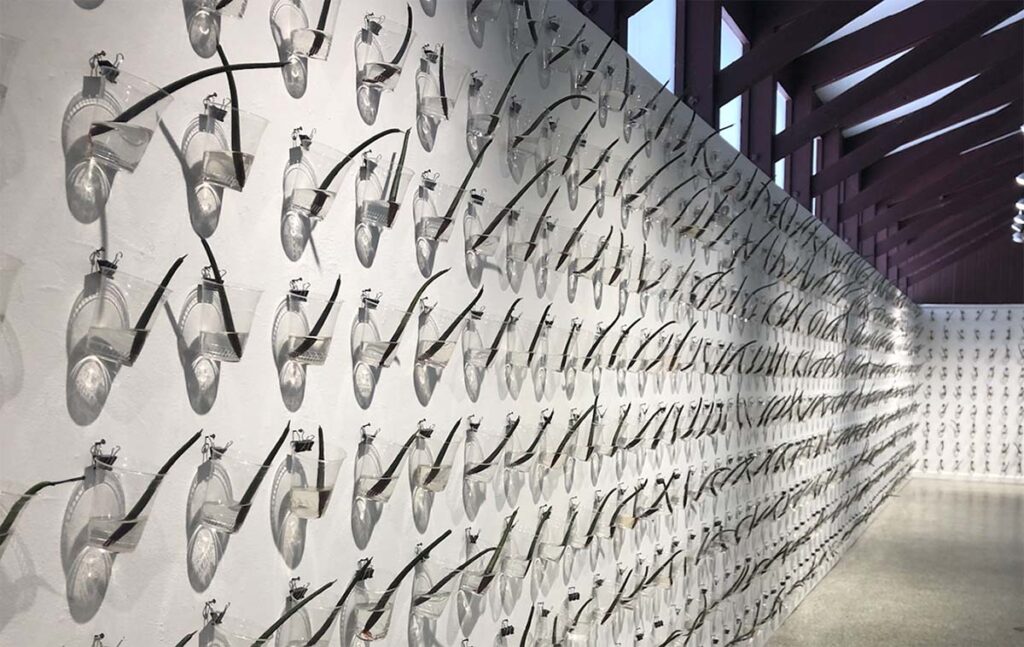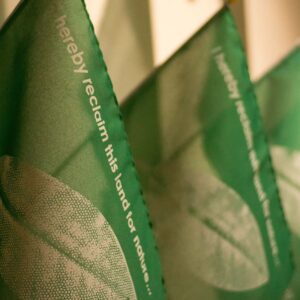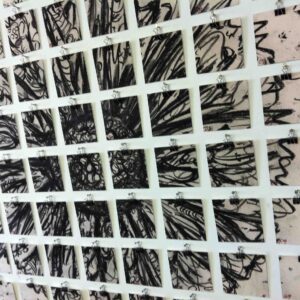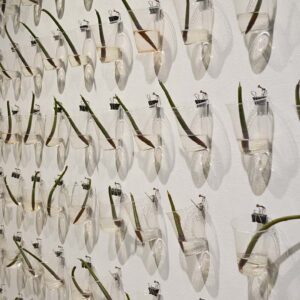

Plan(T), an iteration of Reclamation Project that asks residents to plant a white flag depicting their property elevation and mangrove propagule in their yard, installed at Pinecrest Gardens’ Hibiscus Gallery.
The Reclamation Project lives on today through subsequent iterations in Native Flags, Underwater HOA, Plan(T), FLOR500 and Flower Force, encouraging locals to restore native habitats as coastal cities like Miami plan for a future with rising seas.
Together these five participatory eco-art projects have engaged thousands of people worldwide in taking action against the climate crisis.
Native Flags began June 29, 2008 when Cortada planted a green flag at the North Pole to reclaim the world below for nature and launch a reforestation campaign that rebuilds native ecosystems across the planet. This action was in direct response to modern nations vying for control of Arctic resources that lay below the ice. By planting the flag at this specific location, Cortada was making a symbolic gesture of reclamation by nature, like a “reverse conquistador.”
Participating residents are asked to plant a native tree alongside the green project flag in their front yard and state:
“I HEREBY RECLAIM THIS LAND FOR NATURE.”
Mapping the topography of a conceptual coastline is the basis of Cortada’s Underwater HOA project, necessary “to make the invisible visible.”
Working in conjunction with his Antarctic Ice Paintings from 2006, Underwater HOA is a participatory art project that depicts South Florida’s vulnerability to sea-level rise, specifically the vulnerability of homeowners in South Florida. The goal of this project is to inform citizens on the impending issue of sea-level rise while also facilitating discussions of change within the community by holding monthly “UHOA” meetings. As part of the project, Cortada worked with the Village of Pinecrest to encourage its residents to install a “marker” in their front yard, this marker being a yard sign that depicts the house’s current elevation above sea level above a backdrop of Cortada’s Antarctic Ice Paintings that are literal depictions of melted ice. The introduction of such drastic imagery further emphasizes the urgency of the issues Cortada presents — issues that need to be addressed now.
FLOR500 is a participatory art project initiated in 2013 by Miami artist Xavier Cortada to commemorate the quincentennial of Juan Ponce de Leon’s arrival to the state of Florida. The flower was chosen as the focal iconography of the project for its historical significance in the naming of the state by Ponce de Leon, naming it “La Florida” after the Spanish word for flower – flor. The project, a precursor to Flower Force, was a collaboration between scientists, historians, Florida schools and libraries across 67 counties, and 500 artists.
Flower Force is multi-faceted in operation, an almost natural evolution from Cortada’s previous FLOR500 project that pushes the elasticity of art to the point of recognizable social practice. The project revolves around Florida’s native wildflowers and Cortada’s insistence on mobilizing individuals in the state to plant these flowers within their local communities.
In Plan(T), residents are asked to plant a mangrove propagule in their front yard alongside a white flag with their current elevation above sea-level written across it. The strangeness of the propagule and white flag encourages Miami-Dade residents to start climate conversations with neighbors and guests about carbon sequestration and growing our salt-tolerant native tree canopy in order to safeguard vulnerable areas of our city and provide future seed stock for areas surrendered to rising seas. The tree functions both as a literal act against climate change and sea level rise, as well as a visualization of the growing problem. As the tree is nurtured and grows, so does the vulnerability of the area it resides in, the beauty of the tree juxtaposed with what its growth represents. The mangrove lends itself as a subversive quality in this project, as once the mangrove is planted it is illegal under Florida law to remove it, an allusion to the permanence of the issue at hand.




